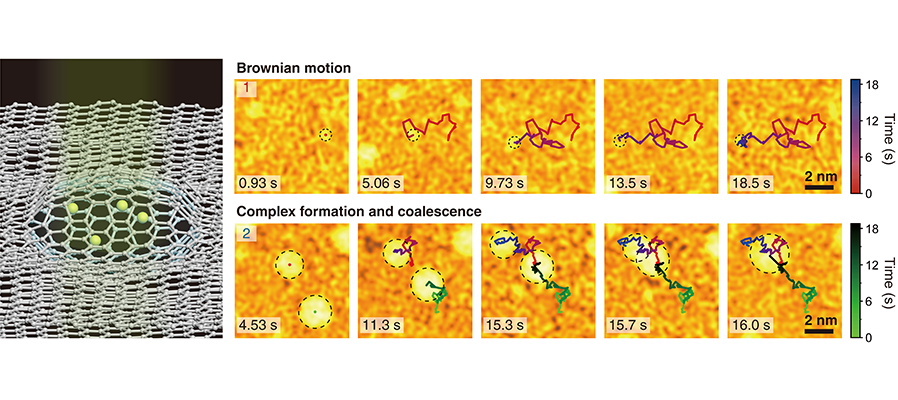Solving a problem regarding motion and reaction of particles in liquids in the ultra-fine world that existing theories cannot explain

From left, Ph.D. student Sungsu Kang and Professor Jungwon Park of the
Department of Chemical and Biological Engineering, Seoul National University
A joint research team of Professor Jungwon Park of the Department of Chemical and Biological Engineering at Seoul National University and Professor Jaeyoung Sung of the Department of Chemistry at Chung-Ang University identified irregular thermal motion in liquid of nanoparticles, as small as a few nanometers through real-time graphene liquid cell (GLC) transmission electron microscopy (TEM). Through this discovery, the research team identified the cohesive interactions between nanoparticles that occur through more than a single step for the first time in the world.
Although the thermal motion and cohesive interaction of particles of micrometer size or larger in a liquid can be well explained by Einstein’s theory of Brownian motion and classical chemical reaction kinetics, whether these theories can explain the motion and cohesive interaction of ultrafine nanoparticles of a few nanometers or smaller in a liquid has been unknown until now. It is challenging to observe ultrafine nanoparticles with an optical microscope, and although it was possible to observe them with a conventional electron microscope, observing the dynamic phenomena of ultrafine nanoparticles in a liquid environment remained a difficulty.
Using a real-time graphene liquid cell (GLC) transmission electron microscopy (TEM), the joint research team succeeded in observing the motion and cohesive interaction of a significant number of ultrafine nanoparticles, which made statistical analysis possible. They also presented a new model and theory to quantitatively explain these experimental results, which could not be explained by existing theories. Notably, the research team developed a method that can accurately extract and analyze even the behavior of nanoparticles that occur below the spatial resolution of an electron microscope. The team also revealed that the cohesive interactions between nanoparticles occur in two stages due to the ligand molecules surrounding the nanoparticles. The fact that the newly developed nanoparticle kinetics explains the experimental results with competence verifies this discovery.
The new research methodology presented in this study is expected to be widely used to observe and understand the liquid phase motion and chemical reaction kinetics of ultrafine nanoparticle systems, which are difficult to study with optical microscopy, using ultra-high-resolution microscopy techniques, including liquid-phase transmission electron microscopy. In addition, it is expected that this study will prompt more studies on changes in physical and chemical properties caused by the nano-confinement environment in aqueous solution systems.
The research findings were published on December 3, 2021, in
<Science Advances>, one of the international academic journals in the field of convergence science.

Figure Redox battery chip without membrane
For further information, please contact Prof. Jungwon Park.


